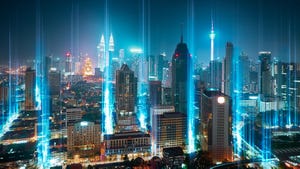
Insight and analysis on the data center space from industry thought leaders.
Behind-the-Meter Energy: Powering Data Centers for a Sustainable Future
As data centers face surging energy demands, renewable energy and behind-the-meter systems are driving more sustainable operations.

Data centers face a dual challenge: soaring energy demands and the push for sustainability. With energy grids strained and climate goals pressing for renewable solutions, operators must rethink their approach to power.
Enter behind-the-meter energy – an innovative strategy offering data centers direct access to renewable resources, cost savings, and resilience in a rapidly evolving energy landscape.
Rising Data Center Energy Demands
Data centers have a problem – energy usage. The UK’s National Energy System Operator, for instance, estimates that data center electricity consumption in the UK could increase by nearly 900% from 3.6 terawatt hours (TWh) in 2020 to 35 TWh by 2050.
The International Energy Agency, meanwhile, expects the amount of energy consumed by data centers to reach 1,000 TWh by 2026, which is about the same amount of electricity as Japan consumes.
Energy grids are already struggling with growing demand across all sectors as a growing number of processes are electrified, which suggests that the surging amounts of energy required to keep data centers operational will pose a significant challenge to grid operators.
When sustainability concerns are added to the mix, the picture seems to be more complicated still.
Optimize for Maximum Value
There are, however, reasons to be optimistic. Renewable energy sources provided 51% of the UK’s electricity in 2023, demonstrating that progress on the energy transition continues at pace. Like all energy users, data centers are benefitting from this.
However, it is vital that data center operators ensure that they make the best possible use of this renewable energy by optimizing operations.
For example, rather than relying on the historical assumption that the best time to schedule operations is at night, data centers that draw a significant amount of power from solar energy may discover that it is more cost-effective to schedule these operations during the day.
Data center operators should also factor in the strong possibility of negative energy prices on particularly sunny or windy days into their energy purchase plans.
Where a problem may emerge for data centers, however, is ensuring they can access a reliable supply of renewable energy. Grid operators continue to face a challenge in clearing the grid connections pathway, whilst also managing the decarbonization challenges posed by grid stability and inertia.
Progress is being made to tackle these challenges. For instance, the proposed planning reforms and initiatives such as the Pathfinder tenders are aimed at helping stabilize the grid. But data centers may still need to look beyond the grid to ‘behind the meter’ for a solution to their energy needs.
The Advantages of ‘Behind-the-Meter’ Energy
Put simply, behind-the-meter energy involves building renewable energy assets directly alongside new data centers or, better still, building data centers near existing renewable energy assets. Doing this enables data centers to be plugged directly into renewable energy, which brings several benefits.
Not only does a behind-the-meter approach guarantee a supply of renewable energy, but it also limits reliance on the grid and reduces operating costs. This is because behind-the-meter energy costs less than energy purchased directly from the grid, while any excess energy generated can also be sold back to the grid.
There are also a range of tax credit schemes to encourage the installation of renewable energy that businesses can utilize to their advantage.
Read more of the latest data center sustainability news
While there are capex costs associated with, for example, installing solar panels on the roof of a data center or placing a wind turbine in a nearby field, operators that are unable to afford this upfront investment still have the option to take advantage of behind-the-meter energy. For instance, they can sign a Power Purchase Agreement (PPA) with an energy provider. PPAs see the data center agree to purchase the energy generated by on- or near-site assets for an agreed price and duration, with the energy provider funding the installation of the assets in full in return.
Corporate PPAs: A Viable Alternative
Where it is not possible to install renewable energy assets in the direct vicinity of data centers, operators can sign Corporate PPAs with energy providers. These agreements see operators purchase renewable energy generated at sites located elsewhere in the UK again at a pre-agreed rate for a pre-agreed duration, offering a viable alternative to behind-the-meter energy.
While this does not offer all the benefits of on- or near-site generation, it does still provide important guarantees on cost, as well as certainty that the energy purchased has been generated by renewable sources.
Behind-the-meter energy will also help data centers optimize operations. That is because the data provided through either CPPAs or by access to behind-the-meter assets offers operators a clear picture of exactly when renewable assets are generating most power.
Indeed, it is now possible to monitor energy usage in considerable detail, which provides businesses with more complete data on energy consumption, source, carbon content and price breakdown. This, in turn, enables better informed decision-making on the utilization of the site and scheduling options by factoring in natural flexibility or resilience, for example.
Tailored Solutions for Energy Resilience
It is important to stress that every data center will need a bespoke solution to manage its own energy needs. There is no one-size-fits-all approach that can solve every problem. But there are approaches that every data centers can use to mitigate the problems that energy supply would otherwise cause – in particular the uncertainty over cost and supply.
By working closely with energy sector experts, it should be possible to develop the right bespoke plan – whether that plan involves is self-funded installation of renewable energy assets or signing a PPA or Corporate PPA, or a combination. Putting such plans into place may require a short-term effort, but the rewards on offer stand to more than make up for that.
About the Authors
You May Also Like











